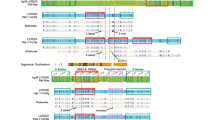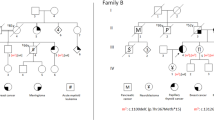Abstract
The absence of detectable germline TP53 mutations in a fraction of families with Li–Fraumeni syndrome (LFS) has suggested the involvement of other genes, but this hypothesis remains controversial. The density of Alu repeats within the TP53 gene led us to search genomic rearrangements of TP53 in families without detectable TP53 mutation. To this aim, we adapted the quantitative multiplex PCR of short fluorescent fragments (QMPSF) method to the analysis of the 11 exons of TP53. We analysed 98 families, either fulfilling (six families) or partially meeting (92 families) the criteria for LFS, and in which classical methods had failed to reveal TP53 alterations. We identified, in a large family fulfilling the criteria for LFS, a complete heterozygous deletion of TP53. Additional QMPSF analyses indicated that this deletion, which partially removed the centromeric FLJ10385 locus, covered approximately 45 kb. This deletion was shown to result from a complex rearrangement involving two distinct Alu-mediated recombinations. We conclude that TP53 germline rearrangements occur as rare events, but must be considered in LFS families without detectable point TP53 mutation.
This is a preview of subscription content, access via your institution
Access options
Subscribe to this journal
Receive 50 print issues and online access
$259.00 per year
only $5.18 per issue
Buy this article
- Purchase on Springer Link
- Instant access to full article PDF
Prices may be subject to local taxes which are calculated during checkout



Similar content being viewed by others
References
Bell DW, Varley JM, Szydlo TE, Kang DH, Wahrer DC, Shannon KE, Lubratovich M, Verselis SJ, Isselbacher KJ, Fraumeni JF, Birch JM, Li FP, Garber JE and Haber DA . (1999). Science, 286, 2528–2531.
Bell DW, Wahrer DCR, Varley JM and Haber DA . (2000). Science, 289, 359 (response).
Birch JM, Hartley AL, Tricker KJ, Prosser J, Condie A, Kelsey AM, Harris M, Jones PH, Binchy A and Crowther D . (1994a). Cancer Res., 54, 1298–1304.
Birch JM, Heighway J, Teare MD, Kelsey AM, Hartley AL, Tricker KJ, Crowther D, Lane DP and Santibáñez-Koref MF . (1994b). Br. J. Cancer, 70, 1176–1181.
Bougeard G, Limacher JM, Martin C, Charbonnier F, Killian A, Delattre O, Longy M, Jonveaux P, Fricker JP, Stoppa-Lyonnet D, Flaman JM and Frébourg T . (2001). J. Med. Genet., 38, 253–256.
Brown LT, Sexsmith E and Malkin D . (2000). Cancer Genet. Cytogenet., 123, 65–68.
Burt EC, McGown G, Thorncroft M, James LA, Birch JM and Varley JM . (1999). Br. J. Cancer, 80, 9–10.
Charbonnier F, Olschwang S, Wang Q, Boisson C, Martin C, Buisine MP, Puisieux A and Frébourg T . (2002). Cancer Res., 62, 848–853.
Charbonnier F, Raux G, Wang Q, Drouot N, Cordier F, Limacher JM, Saurin JC, Puisieux A, Olschwang S and Frébourg T . (2000). Cancer Res., 60, 2760–2763.
Chompret A . (2002). Biochimie, 84, 75–82.
Chompret A, Abel A, Stoppa-Lyonnet D, Brugières L, Pages S, Feunteun J and Bonaiti-Pellie C . (2001). J. Med. Genet., 38, 43–47.
Eeles RA . (1995). Cancer Surv., 25, 101–124.
Li FP, Fraumeni Jr JF, Mulvihill JJ, Blattner WA, Dreyfus MG, Tucker MA and Miller RW . (1988). Cancer Res., 48, 5358–5362.
Meijers-Heijboer H, van den Ouweland A, Klijn J, Wasielewski M, de Snoo A, Oldenburg R, Hollestelle A, Houben M, Crepin E, van Veghel-Plandsoen M, Elstrodt F, van Duijn C, Bartels C, Meijers C, Schutte M, McGuffog L, Thompson D, Easton DF, Sodha N, Seal S, Barfoot R, Mangion J, Chang-Claude J, Eccles D, Eeles R, Evans DG, Houlston R, Murday V, Narod S, Peretz T, Peto J, Phelan C, Zhang HX, Szabo C, Devilee P, Goldgar D, Futreal PA, Nathanson KL, Weber BL, Rahman N and Stratton MR . (2002). Nat Genet, 31, 55–59.
Mighell AJ, Markham AF and Robinson PA . (1997). FEBS Lett., 417, 1–5.
Plummer SJ, Santibáñez-Koref M, Kurosaki T, Liao S, Noble B, Fain PR, Anton-Culver H, and Casey G . (1994). Oncogene, 9, 3273–3280.
Portwine C, Lees J, Verselis S, Li FP and Malkin D . (2000). J. Med. Genet., 37, E13.
Slebos RJ, Resnick MA and Taylor JA . (1998). Cancer Res., 58, 5333–5336.
Sodha N, Williams R, Mangion J, Bullock SL, Yuille MR and Eeles RA . (2000). Science, 289, 359.
Stone JG, Eeles RA, Sodha N, Murday V, Sheriden E and Houlston RS . (1999). Cancer Lett., 147, 181–185.
Vahteristo P, Bartkova J, Eerola H, Syrjakoski K, Ojala S, Kilpivaara O, Tamminen A, Kononen J, Aittomaki K, Heikkila P, Holli K, Blomqvist C, Bartek J, Kallioniemi OP and Nevanlinna H . (2002). Am. J. Hum. Genet., 71, 432–438.
Vahteristo P, Tamminen A, Karvinen P, Eerola H, Eklund C, Aaltonen LA, Blomqvist C, Aittomaki K and Nevanlinna H . (2001). Cancer Res., 61, 5718–5722.
Varley JM, Evans DGR and Birch JM . (1997). Br. J. Cancer, 76, 1–14.
Acknowledgements
We are grateful to Mario Tosi for a critical review of the manuscript and to Qin Wang for providing DNA samples. This work was supported by l'Association pour la Recherche sur le Cancer, la Fondation pour la Recherche Médicale and la Ligue Nationale contre le Cancer. G Bougeard was supported by a grant from le Ministère de la Recherche.
Author information
Authors and Affiliations
Corresponding author
Rights and permissions
About this article
Cite this article
Bougeard, G., Brugières, L., Chompret, A. et al. Screening for TP53 rearrangements in families with the Li–Fraumeni syndrome reveals a complete deletion of the TP53 gene. Oncogene 22, 840–846 (2003). https://doi.org/10.1038/sj.onc.1206155
Received:
Revised:
Accepted:
Published:
Issue Date:
DOI: https://doi.org/10.1038/sj.onc.1206155
Keywords
This article is cited by
-
Ein Update zum Li-Fraumeni-Syndrom
Der Pathologe (2019)
-
The profile and contribution of rare germline copy number variants to cancer risk in Li-Fraumeni patients negative for TP53 mutations
Orphanet Journal of Rare Diseases (2014)
-
Germline copy number variation of genes involved in chromatin remodelling in families suggestive of Li-Fraumeni syndrome with brain tumours
European Journal of Human Genetics (2013)
-
Gastric tumours in hereditary cancer syndromes: clinical features, molecular biology and strategies for prevention
Clinical and Translational Oncology (2011)
-
Early occurrence of lung adenocarcinoma and breast cancer after radiotherapy of a chest wall sarcoma in a patient with a de novo germline mutation in TP53
Familial Cancer (2011)



